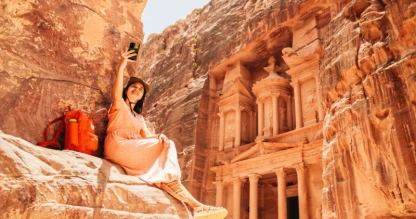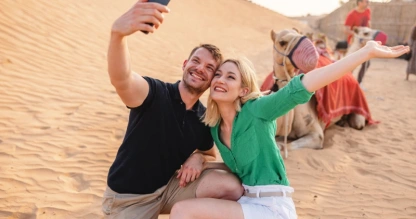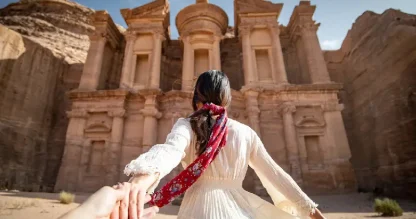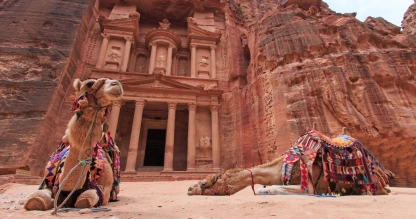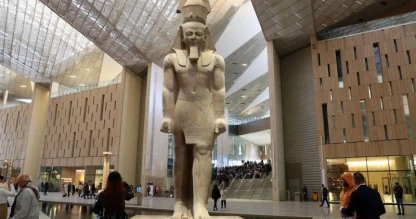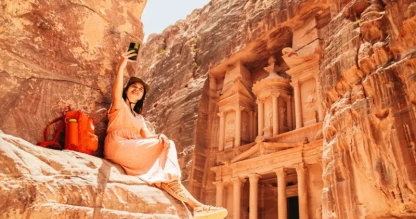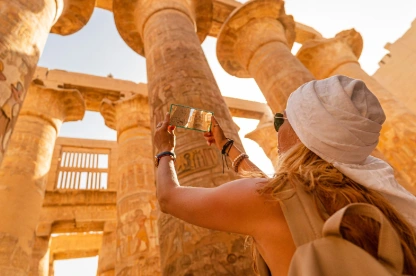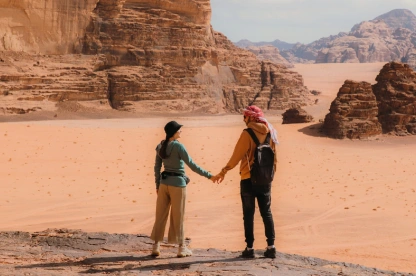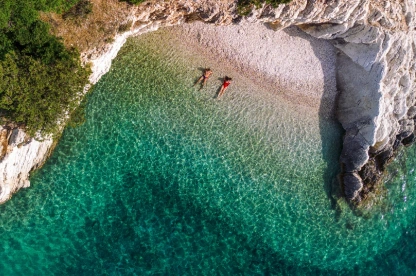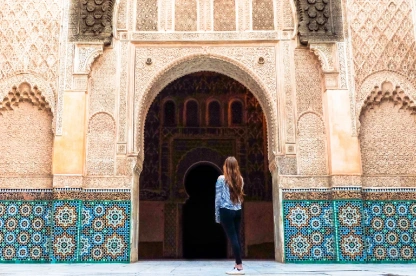Table of Contents:
Wadi Rum Travel Guide: What You Need to Know
Wadi Rum, also referred to as the "Valley of the Moon," is Jordan's most breathtaking destination. The enormous desert terrain is a natural phenomenon characterized by towering sandstone mountains, rust-colored dunes, and an environment so alien-like, it has served as Mars in Hollywood blockbusters such as The Martian and Dune.
One of Jordan's real wonders, Wadi Rum is more than a sightseeing destination - it's an adventure, filled with Bedouin culture and perpetually linked with the great T.E. Lawrence. Hike, camp, or simply enjoy the silence of the sand - this Wadi Rum travel guide will help you find the best things to do in one of Jordan's most unforgettable landscapes.
How to Get to Wadi Rum
Traveling to the breathtaking Wadi Rum desert demands meticulous planning regardless of where your point of departure is in Jordan. This spectacular desert paradise lies about 30 km off the central highway that links Amman and Aqaba, hence easily accessible from Jordan's capital cities.
From Amman, Petra, and Aqaba
Wadi Rum is conveniently linked to Jordan's top destinations, so it is fairly easy to fit into your travel itinerary. Traveling from Amman to Wadi Rum is approximately 320 km and takes around 4 hours by car, with the Jordanian countryside providing scenic views along the way.
If you’re coming from Petra, the distance is much shorter—just over 110 km—making it an ideal next stop after exploring the ancient city. The drive typically takes around 2 hours, and many travelers arrange transportation directly through their hotel in Wadi Musa.
Aqaba, on the Red Sea shore, is the closest city to Wadi Rum. It's about a 68 km drive, a fast 1-hour ride through the southern desert. Aqaba is a popular entry into Wadi Rum, especially for those who would like to spend time on the beach as well as in the desert.
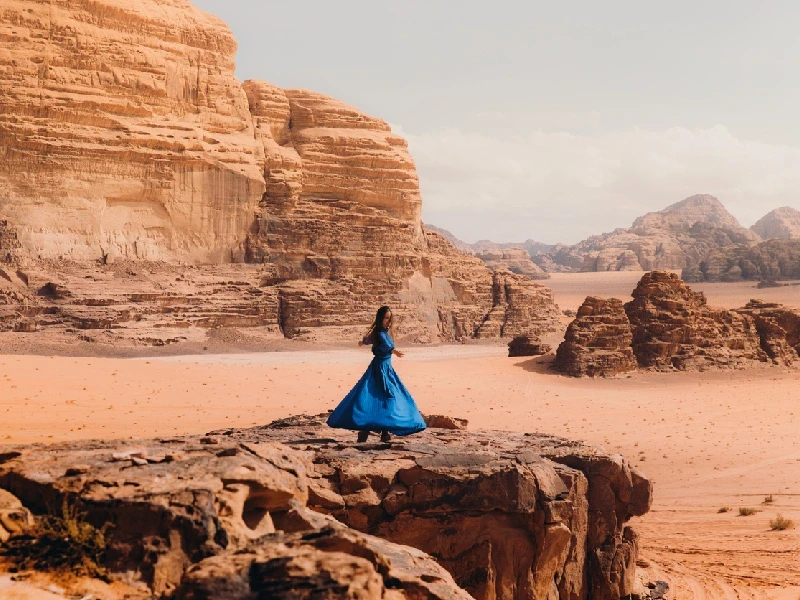
Where to Stay: Choosing the Right Camp
The camps dotted throughout the Wadi Rum terrain offer visitors a variety of desert living experiences ranging from genuine Bedouin hospitality to luxurious retreats. Every type of camp provides distinct opportunities to explore this incredible landscape, and this Wadi Rum travel guide highlights options suited to different tastes and budgets.
Traditional Bedouin tents
Desert camps are actually the essence of desert hospitality. They consist of special tents that are constructed from specialized material that ensures they are warm insulators on the surprisingly chilly nights of the desert.
As opposed to their rustic look, these tents are equipped with essential comforts such as electricity, comfortable beds arranged with fresh bed sheets, plenty of pillows, and warm blankets to keep the night chill off.
Family-operated camps typically boast communal social spaces around crackling fires, natural settings in which guests mingle with fellow travelers and absorb Bedouin cultural wisdom shared by their hosts.
The sensory experience transcends visual attractiveness, with most camps augmenting nights with spine-tingling live traditional music performances and offering genuine Zarb banquets—meats and vegetables cooked for hours in underground sand pits according to ancient desert tradition.
Luxury bubble tents and eco-lodges
The luxury accommodation segment of the desert has come a long way, with Martian domes and futuristic bubble tents now dotting the ancient landscape. These modern structures have transparent ceiling panels that turn humble sleeping quarters into private astronomical observatories, in addition to offering en-suite bathrooms and amenities.
Top Things to Do in Wadi Rum
The out-of-this-world expansiveness of Wadi Rum provides tourists a veritable treasure trove of experiences within its breathtaking red desert landscape. Tourists who venture into the beguiling wilderness discover activities ranging from thrilling thrills to serene cultural activities—all with unhindered vistas of this wonderful region.
Jeep tours and desert safaris
Perhaps the most unforgettable way to explore Wadi Rum's unimaginable, alien-like splendor is on a 4x4 jeep tour—a ride that continues to be the desert's top attraction. The tours provide a spine-tingling journey on what appears to be impassable ground, which is skillfully navigated by local Bedouin drivers as their jeeps make their way through meandering gorges, sweeping dunes, and secret valleys inaccessible on foot.
No matter which choice you make - a short two-hour look or an immersive multi-day adventure - there is not a moment that is not packed with stunning scenery and histories and it`s one of the top things to do in Wadi Rum.
Along the journey, generations of secrets shared by Bedouin guides uncover ancient petroglyphs, identify the region's interesting geological history, and tell tales of adventurers and nomads who once crossed these dunes.
The contrast between the rumbling of the jeep and the stillness of the desert creates a sensory memory that lingers long after your return. For many, this ride becomes the highlight of their time in Wadi Rum—a dynamic blend of raw nature, culture, and adrenaline that truly brings the “Valley of the Moon” to life.
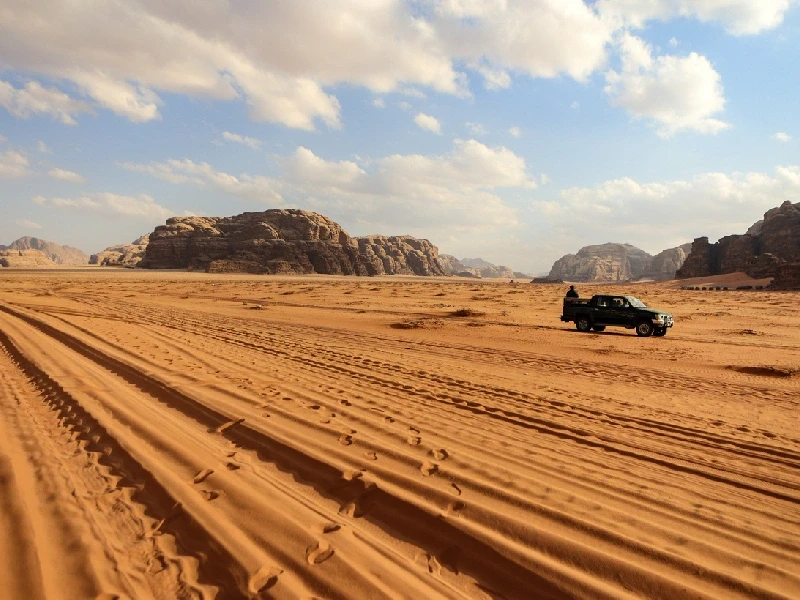
Camel rides and hiking trails
For visitors looking to experience the desert as the previous generations have, camel treks offer an eternal, authentic journey across Wadi Rum's golden sands. Riding on the hump of these magnificent creatures, colloquially referred to as the "ships of the desert," unites riders with the rhythm of Bedouin life, an essential part of things to do in Wadi Rum for those seeking tradition.
For a short stroll or half-day hike with an authentic desert dinner, the unhurried, constant pace renders it simple to completely absorb the serene majesty of the scene.
If you are a walking adventurer, Wadi Rum offers many hiking trails, ranging from easy strolls to tough ascents. Perhaps the most rewarding ascent is Jabal Ram, Jordan's second-highest peak, famously ascended by European climbers in 1952. The path challenges even experienced hikers with its rugged terrain and panoramic views.
For a more contemplative journey, narrow passages like Khazali Canyon reveal ancient petroglyphs etched into sandstone walls—silent storytellers that speak of caravans and cultures long past. Whether by camel or on foot, these traditional paths offer a powerful sense of place and timeless connection to the desert’s enduring spirit.
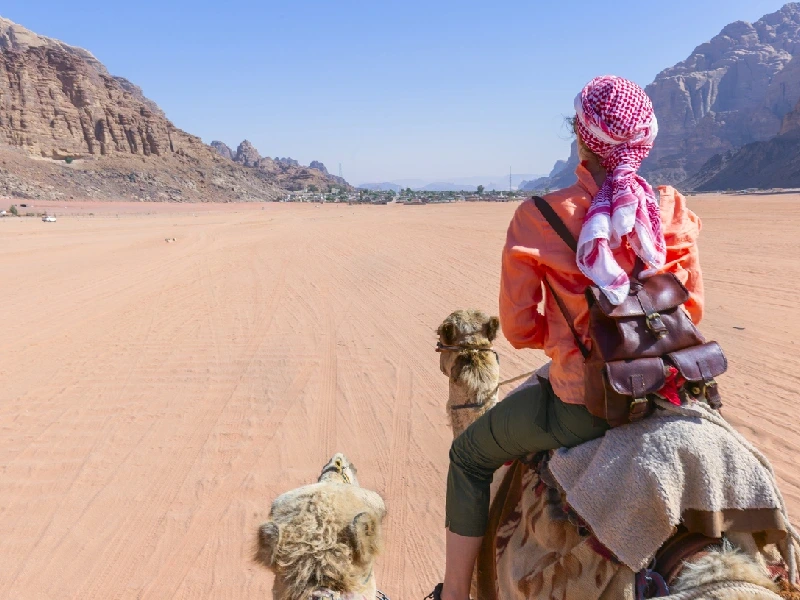
Rock formations and canyons
Impressive sandstone hills preside over the landscape of Wadi Rum, climbing to first be described by climbers in 1984. Superb formations deserve attention: the delicately arched Small Arch, the huge 35-meter high Burdah Rock Bridge over the desert floor, and the tall red dunes which rise at the base of the intimidating Jebel Um Ishrin.
These man-made marvels, molded by millions of years of water and wind, bring photographers and geologists to their doors from everywhere on earth.

Star-gazing and evening photography
The great height of Wadi Rum at 1,000 meters sea level and minimal artificial light with crystal clear desert air all combine to create ideal viewing conditions for astronomy.
Winter nights (November to March) are especially beautiful, with summer nights offering the resplendent arc of the Milky Way in awesome definition. The spooky stillness of the night desert provides a meditative aspect as many stars start to appear by the tens of thousands seldom observed in other more densely populated parts of the world.
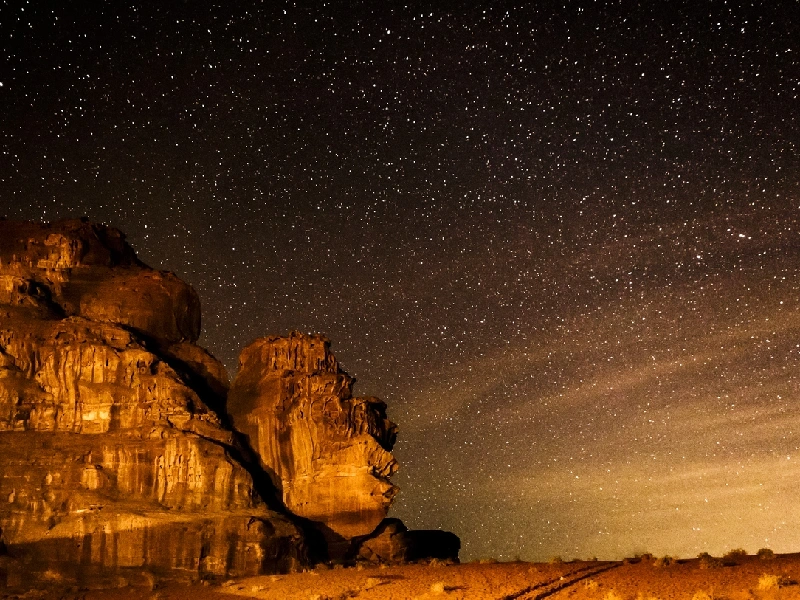
Hot air balloon rides
Early morning hot air balloon rides provide a unique perspective of the vastness of desert scenery. These peaceful flights well above the rough landscape, typically done at the early light of daybreak, allow passengers to soar in peaceful quiet over the dramatic scenery on their tour.
Lawrence of Arabia Landmarks
History enthusiasts specifically enjoy sites with ties to T.E. Lawrence's presence during the Arab Revolt.
Lawrence Spring, Lawrence House, and the picturesque Seven Pillars of Wisdom rock formation (which gave their name to Lawrence's classic memoir) have been attracting tourists since the 1962 opening of David Lean's epic "Lawrence of Arabia" film—its on-screen splendor widely responsible for kick-starting Jordan's tourism industry.
These locations span history and landscape, allowing visitors to tread in the footsteps of this remarkable historical figure.
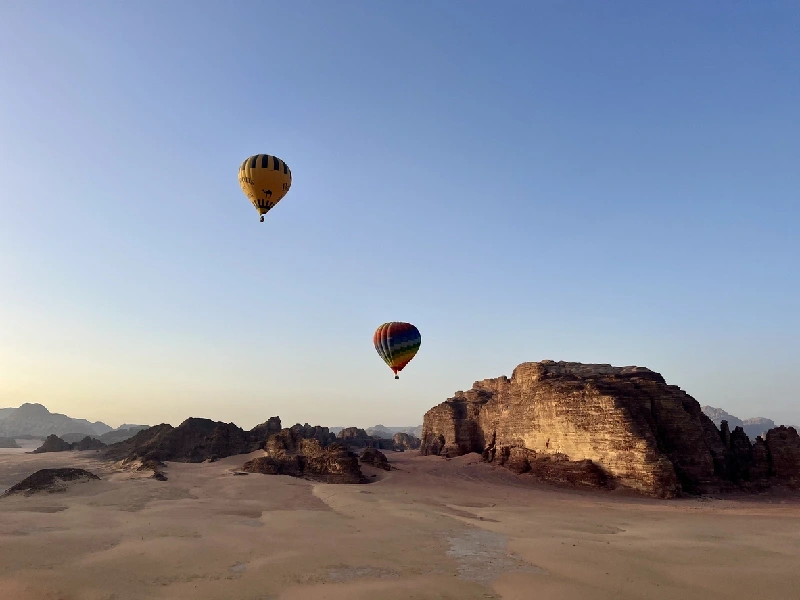
Essential Tips for a Smooth Trip
Desert expeditions demand thoughtful preparation to yield the most rewarding experiences. The following guidance offers crucial advice for visitors venturing into the crimson sands of Wadi Rum.
Best time to visit Wadi Rum
Wadi Rum reveals distinct faces throughout the calendar year. Spring months (March-May) and autumn (September-November) provide visitors with the most favorable conditions—comfortable daytime temperatures well-suited to discovery and adventure.
Visitors who seek quieter and more economical rates might choose January and February, but these months bring decidedly cold nights requiring additional preparation. Summer months (June-July) present temperatures uniformly over 100°F (37°C), limiting pleasant exploration to early morning or post-sunset hours.
Discerning tourists generally prefer late February or November to be that ideal combination of good weather conditions and fewer travel mates.
Nature enthusiasts particularly appreciate visits during spring when the seemingly desolate landscape welcomes visitors with delicate desert blooms and the warm sight of young camels and goats visiting their mothers on the dunes.
What to bring and wear
The desert climate requires special clothing and equipment:
- Clothing: Loose-fitting, long-sleeved garments in pale shades provide superior protection while allowing air circulation.
- Protection: A wide-brimmed hat or traditional headscarf, quality sunglasses with UV filters, substantial sunscreen, and protective lip balm become necessities rather than luxuries.
- Footwear: Comfortable walking shoes or sturdy sneakers for daytime explorations, with sandals offering evening relief.
- Essentials: A reliable flashlight, substantial water bottle, and practical daypack for carrying necessities during excursions.
Winter visitors (Dec-Mar) must include substantial additional layers, as night temperatures drop sharply as soon as the sun goes down.
Cultural courtesy and safety
Being respectful of Bedouin culture significantly contributes to cultural rapport. The right hand is kept strictly for eating, and uttering "Bismillah" when beginning meals and "Al Hamdulillah" at the end of meals shows respectful adherence to local practice. Covered shoulders and knees in attire show proper cultural sensitivity.
Safety protocols include reporting climbing itineraries to Tourism Police and carrying water levels more than what seems presently necessary. Good tourism dictates maintaining vehicle paths and not destroying natural features—plants, boulders, artifacts—to have others enjoy in the future.
Food and water supply
Bottled water is a necessity, since the locally available tap water is not deemed safe for consumption. Responsible visitors stock up from Wadi Rum village, with modest but effective shopping facilities and a welcoming coffee shop.
Any well-organized tours thoughtfully include meals, rationed water, and stopover snacks in between. The night meal can consist of the world-famous Bedouin zarb—a timeless feast slowly cooked under the dunes of desert sands, with authentic aroma and cultural essence.
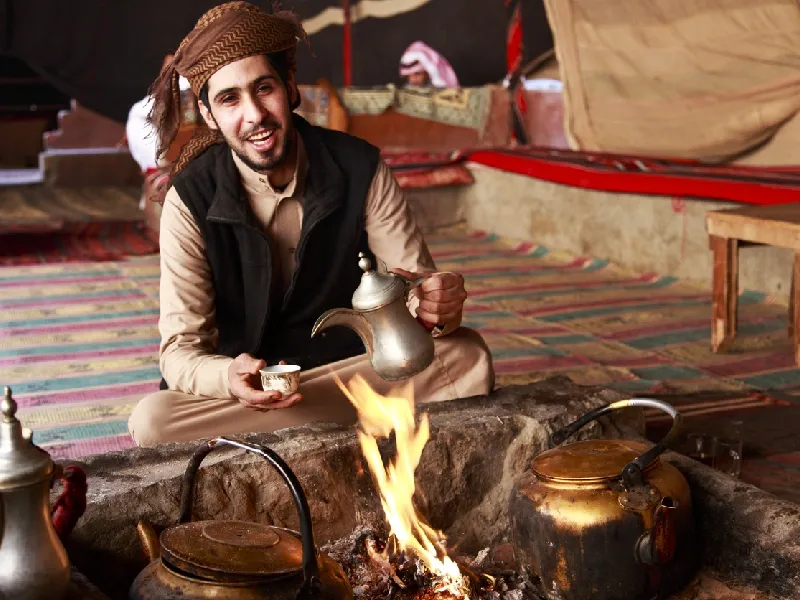
Frequentaly asked questions
Q1. What is so special about Wadi Rum?
Wadi Rum is a surreal desert of red sand and towering sandstone formations—featured in many films. This wadi rum travel guide highlights its unique Martian-like terrain and Bedouin heritage.
Q2. How much does it cost to enter Wadi Rum?
The entrance fee for Wadi Rum is 5 JD per adult, free for children under 12. It's waived with the Jordan Pass.
Q3. Is Wadi Rum worth a visit?
Absolutely. From jeep tours and camel rides to stargazing, the range of things to do in Wadi Rum makes it one of Jordan’s most unforgettable destinations.
Q4. Is 1 day enough for Wadi Rum?
You can cover the top things to do in Wadi Rum in a full day, but staying overnight in a Bedouin camp enhances the experience.
Q5. Can you walk in Wadi Rum?
Yes! Wadi Rum offers excellent hiking trails, from scenic walks to climbs—perfect for those exploring the wadi rum travel guide on foot.
Q6. Which month is best for Wadi Rum?
According to any solid wadi rum travel guide, spring (March–May) and autumn (September–November) offer ideal weather for desert adventures.
Ready to explore Jordan and the best destinations in the Middle East? Book your combined tours now!
Find Other Blogs
Explore the 10 best things to do in Dubai, from world-famous sights and thrilling adventures to unique cultural experiences for every type of traveler.
Explore the best destinations in Middle East, from ancient wonders to modern marvels, perfect for culture lovers, adventure seekers, and beach fans alike.
Explore the timeless wonders of Egypt, from ancient pyramids to majestic temples, in this ultimate guide to the country’s most iconic sites.
Explore the magic of Wadi Rum, Jordan’s desert gem filled with red sands, towering cliffs, and unforgettable Bedouin adventures.
Get ready for your trip with these essential Turkey travel tips, covering culture, food, key sights, and must-know advice for first-time visitors!
Discover the rich flavors of Moroccan cuisine: tajines, couscous, street bites, and sweet treats you won't want to miss!
Discover the best beaches in Greece, from hidden gems to iconic shores, on unforgettable Greece tours filled with sun, sea, and stories.
Discover the most visited places in Istanbul, including top sites, historic landmarks, and must-see spots in this vibrant city.
Experience the thrill of a Dubai desert safari with dune bashing, camel rides and sunset views in one unforgettable adventure.
Explore the imperial cities of Morocco, Fez, Marrakesh, Rabat, and Meknes and experience rich history, culture, and stunning architecture.


